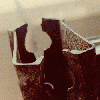Kansas City Hyatt Regency Walkway Collapse


In the 1970's an architect named John Portman was designing buildings with wide open spaces. The idea became very popular and Crown Center Redevelopment decided to design their new Hyatt Regency Hotel with an atrium similar to Mr. Portman's designs.(3) The hotel was designed and in early 1979, a change was made to the design. Changes in designs are not uncommon during construction, but it turned out that this one change (there were hundreds of changes made to the design during construction of this huge hotel and conference center) turned out to be deadly. A low level steel fabricator working for Havens Steel changed the design from one hanger rod holding the walkways in the atrium to two hanger rods.[Click here for a more complete explanation]The design change was shown to his superiors (including the engineering firm G.C.E., who eventually took most of the blame for the disaster). Havens Steel also called G.C.E. about the change but G.C.E. claims that they didn't recieve the call(5). Either way the design was changed and two rods were installed in the fourth floor beam instead of one.
In fact, the hanger rod connection change was one of 42 changes G.C.E. recieved in February 1979 alone. They were all returned to Haven Steel stamped with an approval on February 26. On October 14, part of the atrium roof collapsed during construction, and a team of investigators is called in by the owner, Crown Developers, to investigate the roof collapse. These inspectors, however were under no obligation to look into problems in the design of any other aspects of the project like the hanger rod connection to the walkways. The owners were assured of the safety of the design and the hotel opened in July 1980.(8)

On July 17, 1981 the nut holding the hanger rod to the fourth floor walkway breaks through the beam it is secured against and two walkways collapse: the fourth floor and the second floor, which is hanging from the fourth floor walkway alone. 114 people are killed and more than 200 others are injured as the people standing on the walkways fall with the mass of concrete and steel several stories down to land on more people. Unfortunately, the two falling walkways were directly above the bar, where the crowd was most dense. People on the first floor were not only hit by the walkways, but also by bodies.(4)
The job of the design team is to imagine any possible way that the structure could fail. A failure is not necessarily a catastrophe either. Sometimes a failure can simply be cracking in a roadway several years before the engineers expected it to crack. The design team must not only design the structure to stand-even a card castle will stand- they also need to imagine any possibility of how their structure could become weaker and thus unsafe over time. Once they imagine something that could go wrong, they must test the design by submitting smaller prototypes of the building to severe tests in the labratory. If the tests show that the building could weaken, they must redesign it and try it again. Even the ancient Egyptians used this trial and error method when they were building the pyramids.(2) The problem in the Hyatt Regency disater was that when the design was changed, the new design was not tested, for if it were tested Even a sophomore engineering student would realize that the walkway would coolapse with simple calculations that he could have done on the construction site on the back of an envelope.(1)
A commission was sent to investigate the disaster to try to find out who was responsible. On November 15, 1985, their findings were reported to the court and G.C.E. International, Inc. was found guilty of "gross negligence, misconduct and unproffesional conduct in the practice of engineering."(6) Many of the other companies involved had to file for bancruptcy including Havens Steel Also, the general contractor, Eldridge Construction went out of business following the event.
Daniel Duncan and his boss Jack Gillum, who owned G.C.E. both lost their engineering liscenses. (6) Jack Gillum became a public enemy and his carrer was ruined. In recent years, Mr. Gillum has recieved a new liscence of engineering, but he certainly will have trouble in an industry where most people know him as being responsible for the disaster in Kansas City. Many of Mr. Gillum's colleagues, including William Nash, think that he did not deserve the blame that he got, however. It is Mr. Nash's very strong opinion that Mr. Gillum was not aware of Mr. Duncan's mistake in approving the design change. (5)
All images from www.engineering.com for more pictures,click here.
CLICK HERE FOR A CHRONOLOGY taken from source (8)
Go to this page and click the first link to read the pdf version of the Missouri Board of Architects, Professional Engineers and Land Surveyors report to the State of Missouri
Some highlights include:
The Finding of Fact that "Although factors such as capabilities and experience may enter in, the primary factor in choosing a construction team member is lowest bid."
"...there is no contractual or privity of contract between the structural engineer and the steel fabricator."
IEEE Code of Ethics